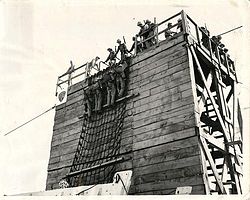Movement and Reassignment
On 1 July 1971 the squadron was redesignated to its present name, MWCS-48. [1] An additional Squadron was formed, Marine Wing Communications Training Squadron 407 (MWCTS-407). This Squadron was composed of the four platoons that would have normally been assigned to the Marine Air Base Squadron of each one of the Marine Air Groups. The theory was that they would receive better training by consolidating the platoons in one unit. There were subordinate units in El Toro, CA, Alameda, CA, Willow Grove, PA, and Glenview, IL.
The Squadron was located in the City of Chicago just south of White Sox Park on 35th Street in an old tank factory, now used as a gymnasium for the Chicago Police Department. This large red brick building contained a very large drill deck where training on equipment could be conducted.
Equipment in the late 1960s and 1970s included AN/TRC-75 and TSC-15 HF Radios, MRC-62 and TRC-27 Multichannel equipment, and SB-22 and SB 86 Switchboards and EE-8 and TA-312 telephones. Later in the 1970s the unit transitioned to more modern equipment, including MRC-135s and TRC-166 and TRC-97.
In 1974 both Squadrons moved from Chicago to Naval Air Station Glenview, Illinois.
MWCTS-407 was merged into MWCS-48 in 1975. There are three active duty Communication Squadrons in the Marine Corps, MWCS-18, MWCS-28, and MWCS-38, and one in Reserve, MWCS-48. They each support a Marine Air Wing, three active duty and one in Reserve.
The Squadron supported numerous exercises throughout the United States. The Squadron supported numerous Combined Arms Exercises (CAX) in 29 Palms, Weapons Training Instruction (WTI) in Yuma, Arizona, and exercises at Camp Pendleton, Camp Lejeune, Cherry Point, and Quantico.
The Exercise High Intercept at Cherry Point in 1985 was a high point, where electronic warfare was a principle portion of the exercise, and where Radio Battalion told the Squadron that they were the best unit that they had ever worked against. The Commanding General of 4th MAW commended the Squadron for these efforts.
The Squadron also developed "Fly Away" weekend comm exercises. A VMGR-234 Glenview C-130 would fly a detachment out to El Toro or Yuma or New Orleans. Two MRC-135 multichannel radio jeeps would be transported, driven to mountain tops in southern California, and multichannel radio links would be established. These fly away drills were excellent for morale. The unit also used HM-776 Huey Helicopters from Glenview, which was highly motivating for the troops.
The Squadron flew C-119 Flying Boxcars to Norfolk, VA on one long winter weekend for dry net training. The flying boxcar was the only multi engine military aircraft that would not fly if it lost one engine. The troops were given parachutes and instructed on how to use them if the order was given to jump from the airplane. The first plane did not have enough power to leave Glenview, so another one was obtained. The door was secured with a large leather strap, and the front wheel cranked up with a long lever. The weather was very bad nearly leading to a crash at Norfolk.
The unit specialized in long range difficult multichannel shots. The unit successfully established and operated shots between El Toro and 29 Palms and to Yuma Arizona, using MRC-135 jeeps on mountain tops. Two MRC-135 shots and a TRC-66 link would be established. The unit also used the Prudential building in downtown Chicago to relay information between the Joliet Arsena and NAS Glenview.
Officers and Staff NCO's attended numerous schools, including Landing Force Communications Planning in Coronado. Marine Amphibious Brigade Planning, NAB Coronado CA, Aviation Staff Planning Course, LFTCPAC Coronado CA, NATO Electronic Warfare Course at SHAPE Headquarters in Oberammergau, West Germany, Air Control Operations Course, LFTCLANT, BLT/RLT Operations Planning, LFTCLANT, Little Creek VA, Electronic Warfare Course conducted by the German Army at the German Army Signal School, Feldafing GDR.



